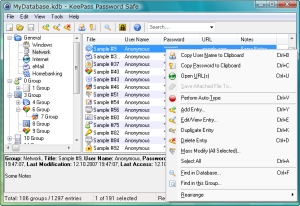IBM Developer Works Days 2012.
14 -15 Nov 2012
General Trends in Development
- The term “GUI” is promoted to “User Experience” !
- IDE’s and Technologies are trying to prove all the time that they are Agile oriented.
- Applications Should be seen as a Service not a product.
- Domain Specific Languages (DSL) are languages meant for non-developer application users to be able to perform activities on the system without developer involvement. I see it as one step forward from API’s but for users not developers. (just like how SQL was meant to be for databases).
- Mixed Environments , more that one technology (or programming language) in one application to provide a service.
- Mobile development is gaining ground and attention for accessing mobile B2C and B2B.
- Office-Automation using mobile applications for the corporate employees.
- BIG Data.
- There is still a lot of work for developers to do.
Read more »
Some use Excel, Others simply use text files to keep track of their passwords, but I use keepass .
It is simply a vault for your logins and passwords which you can unlock with a single password. However I use it also for auto-piloting my login procedure.

keepass main window
The whole idea is not to have to use a pool of passwords for all systems and also to auto-start you log-in procedure and save waring off your precious fingers in typing useless usernames and passwords.
In this article I will show how to use keepass to auto-login to:
- Putty
- WinScp
- Toad
- SQLPLUS
- SiebelTools
- FieZilla
And from the examples above you would be able to use it with any command line tool as well.
You could also use it for keeping track of your web site usernames ,passwords and URL’s
It is available on Windows, Mac, Linux, Android and iPhone.
Read more »
Tags: auto login, database, environments, fast, keepass, linux, Oracle, password, Production, Productivity, quick, support, unix, username, vault
 Excel, Introduction, PC Utilities, Productivity Tools, Siebel, SQL | asmaklad, 13 Jul 12 |
Excel, Introduction, PC Utilities, Productivity Tools, Siebel, SQL | asmaklad, 13 Jul 12 |  Comments Off on Productivity : Use Keypass to keep track of your environment’s credentials,
Comments Off on Productivity : Use Keypass to keep track of your environment’s credentials,
If you are an enterprise developer, then you must have came across SOAP (Simple Object Access Protocol).
When you are first introduced to it, you drown in a ocean of terms and jargon that eventually kills the purpose of it (Simple).
In this this 100 minutes tutorial I try to introduce the reader to SOAP jargon without being stuck in the Jargon Quick sand. I try to introduce terms naturally and gradually as they are needed and as much as possible try to provide visual exhibits to reduce the number of words.
Read more »
Tags: HTTP, Objects, REST, RPC, SOAP, Web Technologies, XML, XML-RPC
 Introduction, Java, JEE, Uncategorized, Web Technologies, XML | asmaklad, 9 Dec 10 |
Introduction, Java, JEE, Uncategorized, Web Technologies, XML | asmaklad, 9 Dec 10 |  Comments (2)
Comments (2)
Introduction:
Billing systems in telecom are pivotal for the operation of any telecom operator. In this article I explain some of the terminologies about telecom and try to show how they fit in the big picture in telecom operators.
Also I explain the Customer, Network and Money triangle which helps in defining functionalities of the Billing system and maybe IT Applications inside the telecom operator matrix of business processes.
The ideas discussed in this article is intended to be as generic as possible and based on my personal perspective.
Read more »
Tags: Billing, BSCS, Business Model, ERD, GSM, SIM, telecom
 BSCS, Introduction, Oracle BRM, Telecom Billing, Uncategorized | asmaklad, 12 Nov 10 |
BSCS, Introduction, Oracle BRM, Telecom Billing, Uncategorized | asmaklad, 12 Nov 10 |  Comments (7)
Comments (7)
Time for another tutorial: XML in 100 minutes.
XML today is a vital technology in contemporary organizations, it is widely used to transfer data between applications and other uses.
Knowing XML for today’s IT Gurus is as important as Unix and SQL skills. Many Applications requires XML know-how.
This short guide to XML is only an fast introduction to XML, later tutorials will follow about the individual subjects in XML, like XSLT, SOAP …etc.
The tutorial is available here in PDF, HTML and Adobe-Flash Formats
One of the slides has an overview of XML technologies:

XML at a glance
Read more »

